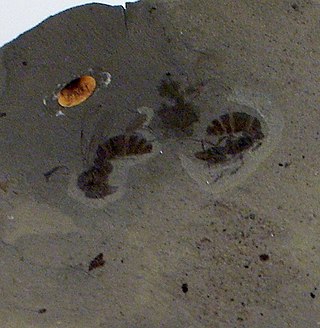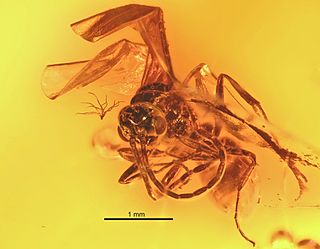
Ypresiomyrma is an extinct genus of ants in the subfamily Myrmeciinae that was described in 2006. There are four species described; one species is from the Isle of Fur in Denmark, two are from the McAbee Fossil Beds in British Columbia, Canada, and the fourth from the Bol’shaya Svetlovodnaya fossil site in Russia. The queens of this genus are large, the mandibles are elongated and the eyes are well developed; a stinger is also present. The behaviour of these ants would have been similar to that of extant Myrmeciinae ants, such as solitary foraging for arthropod prey and never leaving pheromone trails. The alates were poor flyers due to their size, and birds and animals most likely preyed on these ants. Ypresiomyrma is not assigned to any tribe, and is instead generally regarded as incertae sedis within Myrmeciinae. However, some authors believe Ypresiomyrma should be assigned as incertae sedis within Formicidae.

Emplastus is an extinct morphogenus of ants in the subfamily Dolichoderinae, known from fossils found in Asia and Europe. The genus contains twelve species described from sites in England, Eastern Europe and Far Eastern Russia.

Yantaromyrmex is an extinct genus of ants first described in 2013. Members of this genus are in the subfamily Dolichoderinae of the family Formicidae, known from Middle Eocene to Early Oligocene fossils found in Europe. The genus currently contains five described species, Y. constrictus, Y. geinitzi, Y. intermedius, Y. mayrianum and Y. samlandicus. The first specimens were collected in 1868 and studied by Austrian entomologist Gustav Mayr, who originally placed the fossils in other ant genera until the fossils were reviewed and subsequently placed into their own genus. These ants are small, measuring from 4 to 6 mm in length and can be characterized by their trapezoidal shaped head-capsules and oval compound eyes that are located slightly to the rear of the capsules midpoint, with no known ocelli present.
Cananeuretus is an extinct genus of ant in the Formicidae subfamily Aneuretinae, and is one of two Cretaceous genera of the subfamily. The genus contains a single described species Cananeuretus occidentalis and is known from one Late Cretaceous fossil which has been found in North America.

Gerontoformica is an extinct genus of stem-group ants. The genus contains thirteen described species known from Late Cretaceous fossils found in Asia and Europe. The species were described between 2004 and 2016, with a number of the species formerly being placed into the junior synonym genus Sphecomyrmodes.
Dolichoderus pinguis is an extinct species of formicid in the ant subfamily Dolichoderinae known from a fossil found in Asia. The species is one of a number in the genus described from fossils.
Formica biamoensis is an extinct species of formicid in the ant subfamily Formicinae known from fossils found in eastern Asia.
Aneuretellus is an extinct genus of ant in the formicid subfamily Aneuretinae, and is one of eight genera of the subfamily. The genus contains a single described species Aneuretellus deformis and is known from one Middle Eocene fossil which was found in Sakhalin in the Russian Far East.

Bradoponera is an extinct genus of ant in the Formicidae subfamily Proceratiinae, and is one of four genera of the subfamily. The genus contains four described species Bradoponera electrina, Bradoponera meieri, Bradoponera similis, and Bradoponera wunderlichi. The species are known from several Middle Eocene amber fossils which were found in Europe.
Formica paleosibirica is an extinct species of formicid in the ant subfamily Formicinae known from fossils found in eastern Asia.
Gesomyrmex macrops is an extinct species of formicid in the ant subfamily Formicinae known from a fossil found in eastern Asia.
Gesomyrmex magnus is an extinct species of formicid in the ant subfamily Formicinae known from a fossil found in eastern Asia.
Pachycondyla oligocenica is an extinct species of formicid in the ant subfamily Ponerinae known from a fossil found in eastern Asia.
Pachycondyla aberrans is an extinct species of formicid in the ant subfamily Ponerinae known from a single fossil found in Russia.
Agastomyrma is an extinct genus of formicid in the ant subfamily Myrmicinae known from the fossil species Agastomyrma laticeps found in eastern Asia.

Electromyrmex is an extinct genus of ants in the formicid subfamily Dolichoderinae. The genus contains a single described species, Electromyrmex klebsi and is known from a group of Middle Eocene fossils which were found in Europe.

Pachycondyla succinea is an extinct species of ant in the formicid subfamily Ponerinae described from fossils found in Europe. P. petrosa is one of three middle Eocene Pachycondyla species found in Baltic amber.

Odontomachus spinifer is an extinct species of ant in the subfamily Ponerinae known from one possibly Miocene fossil found on Hispaniola. O. spinifer is one of two species in the ant genus Odontomachus to have been described from fossils found in Dominican amber and is one of a number of Odontomachus species found in the Greater Antilles.

Odontomachus pseudobauri is an extinct species of ant in the subfamily Ponerinae known from one possibly Miocene fossil found on Hispaniola. O. pseudobauri is one of two species in the ant genus Odontomachus to have been described from fossils found in Dominican amber and is one of a number of Odontomachus species found in the Greater Antilles.

Nylanderia pygmaea is an extinct species of formicid in the ant subfamily Formicinae known from fossils found in the Prussian Formation of the Baltic region.











